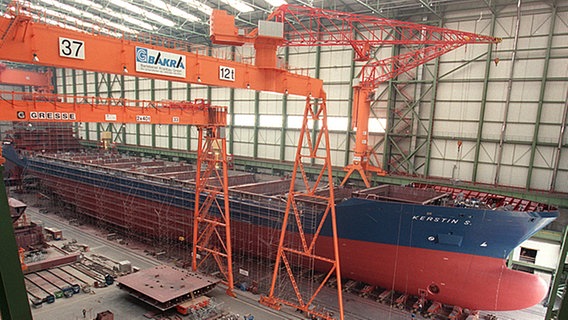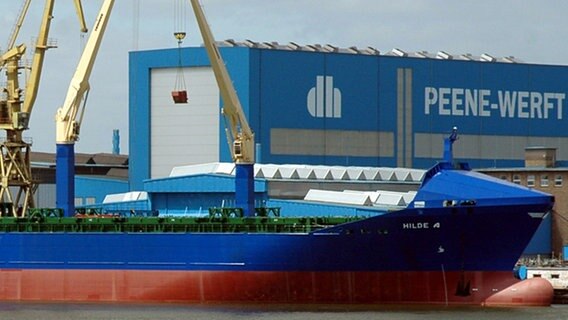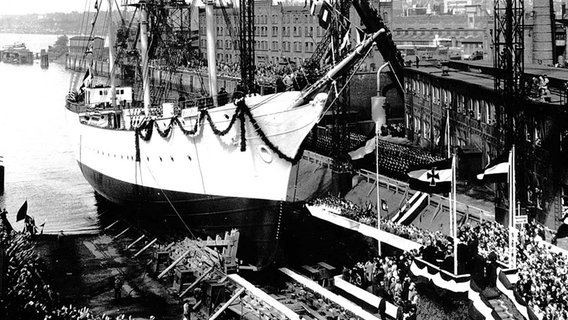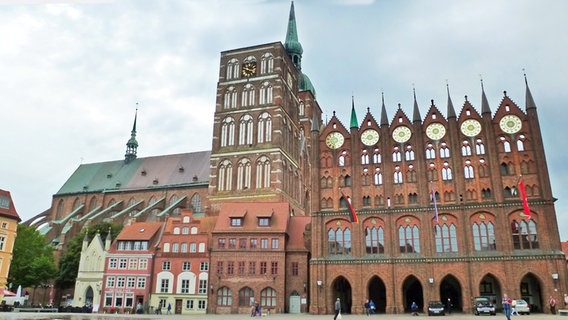Status: 07.06.2023 5:00 a.m
On June 7, 1948, the starting signal was given for the Volkswerft – by order. In GDR times, primarily fishing ships were built on the Strelasund, after the reunification container freighters, special buildings and cruise ships. The shipyard is now history – almost.
Photography strictly forbidden! This clear warning applies to the entire Volkswerft site in Germany for years Stralsund. With good reason: the armaments orders from the shipyard should remain secret. beginning of 1950s rank the security interests of the DDR and the Soviet Union because of the Cold War and the Korean War at times before the original core tasks: the construction of fishing ships. The Volkswerft produced the first mine laying and clearing ships between 1952 and 1954. They are almost 60 meters long and equipped with a 37 mm gun and depth charge launchers, among other things. The ships, designed for a crew of 38, have the name “Habicht” in naval German. They are used by the naval forces of the GDR.
Six months for a functioning shipyard
In September 1991, a factory trawler manufactured for the Soviet Union is pulled by tugboats from the site of the Stralsund shipyard.
The beginnings of the shipyard go back to that End of World War II: The Soviet Union is a great power without a fleet. In addition, their ill-equipped fishing boats are unable to catch enough to alleviate the country’s plight. For this reason, the Soviet military administration in Germany issues Order No. 103 on June 7, 1948. This regulates the military construction of a shipyard as part of the reparation demands. Ingenieurbau GmbH, which has been based in Stralsund since 1945, becomes the property of the people. It forms the basis for the new Volkswerft. The order provides for the shipyard to be put into operation from January 1, 1949 – in just six months. This requirement requires a departure from traditional shipbuilding. Industrial production methods and series production are now required. The all-welded hull becomes standard.
Submarine plans fell through
In 1952 the GDR plans to set up its own submarine fleet. one during the second worldwar German submarine that sunk off Warnemünde is to be raised first and used as a template after reconstruction. But after the transfer to Stralsund, an accident occurs in the shipyard in November 1952: the wreck detaches itself from its anchorage and falls onto the rail system of the shipyard. An accident with consequences: the entire production of the Volkswerft was suspended for almost a month. The police arrested project manager Rudolf Gellert on charges of sabotage. Gellert was only released after five months in prison. Although the GDR maintains its own submarine training institute and the secret specifications provide for the construction of 14 submarines and 55 so-called submarine hunters in the period from 1954 to 1957, the accident means the premature end of the submarine Plans in the Volkswerft.
Fishing trawler specialist
In 1958 Volkswerft took over the shipbuilding and repair yard in Stralsund (SRS). Post-merger SRS will focus on ship repairs. Special vessels for fishing – such as freezer and factory trawlers – make up the 1980s the main business of the mother shipyard. They are their figureheads. middle of 70er the location is considered the most modern East German shipbuilding plant. Between 1975 and 1989, the Stralsund company – measured by tonnage – took first place nine times among all shipyards worldwide that build fishing ships. Their tonnage share in the world production of these ships increases to 33 percent. The Volkswerft is also responsible for floating cranes, transport, research and training ships. With a few exceptions, all ships built sailed under the Soviet flag until the end of the GDR. Other customers are Bulgaria, Romania and Cuba. After turn Volkswerft opens up new business areas. The first container ship named “Alexandra” was launched in December 1992. The following year, the Stralsund shipbuilders deliver a combined passenger and cargo ship for the first time. Customers now include Norway, Indonesia and China.
post-reunification turbulence
After fall of the wall In June 1990, the state-owned shipyard was converted into the Volkswerft GmbH corporation. It becomes a subsidiary of Deutsche Maschinen- und Schiffbau AG in Rostock. The Volkswerft is supposed to build and deliver 45 trawlers for the Soviet Union until 1995. But that doesn’t happen, the clients are insolvent. A construction freeze means that almost half of the approximately 7,000 shipbuilders will lose their jobs. In 1993, the trustee board of directors approved the privatization of Volkswerft GmbH. It is the last East German shipyard to undergo this transformation. A consortium of bidders led by the Bremer Vulkan association takes over the shipyard for one million marks, that is a good 510,000 euros. The conversion to a compact shipyard takes place – a necessary step in order to preserve the traditional shipyard.
After Vulkan bankruptcy narrowly avoided bankruptcy
In 1996, however, Vulkan filed for court settlement proceedings due to insolvency. Funds planned for Stralsund in the amount of 850 million Deutschmarks – almost 435 million euros – are no longer available. The location is in danger. Last but not least, thanks to the great commitment of the Stralsund citizens, politicians and shipbuilders, the Volkswerft was finally able to detach itself and narrowly avoided bankruptcy. The shares are now held by the federal government, the state of Mecklenburg-Western Pomerania and the city of Stralsund.
New owners, new direction, new worries
At the beginning of 1998, the Danish group of companies AP Møller took over the shipyard, followed by Bremer in mid-August 2007 Hegemann Group. She joins her in the construction of large container ships. The group also includes the Peene shipyard in Wolgast and the Roland shipyard in Berne, Lower Saxony. In the meantime, owner Detlef Hegemann is considering renaming the shipyard from Volkswerft to Hansewerft, since this name suits the Hanseatic city well. Out of consideration for the protesting workforce, he ultimately decided not to take this step.
In mid-2010 the Volkswerft merged with the Wolgaster Peene shipyard. New name: P+S shipyards. Container freighters are no longer the focus because demand is falling. The special shipbuilding, for example with river cruise ships, becomes the new orientation. 1,925 employees work at the two locations in Wolgast and Stralsund.
End of tradition: shipyard gets new names
The P+S Group has to file for bankruptcy in August 2012. The employees initially receive the so-called insolvency allowance, and a rescue company is founded. In May 2013, the Wolgast shipyard went to the Lürssen Group in Bremen. 750 employees in Stralsund will become unemployed in November 2013. Only 200 people are still employed at Volkswerft. A buyer for the traditional company has been sought for a long time. In April 2014, it was announced that the Nordic shipyards would take over the Stralsund shipbuilding company on June 1, 2014 – for 6.5 million euros. The Russian Nordic Yards owner Vitaly Yussufow wants to have systems for wind farms built at sea. A use for shipbuilding is not excluded. Almost casually, something else falls victim to the changes: the traditional name “Volkswerft” is replaced by “Nordic Yards Stralsund”.
Genting relies on cruise ships – and fails
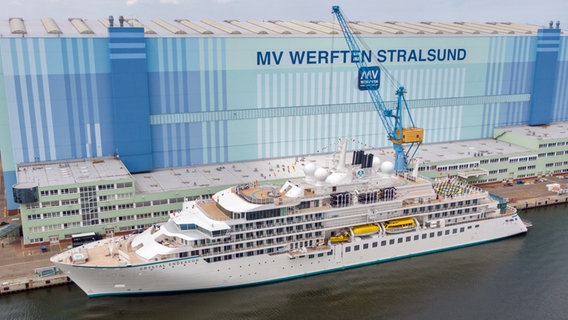
The expedition cruise ship “Crystal Endeavor” will be completed and christened in Stralsund in 2021.
At the beginning of March 2016, the Asian conglomerate Genting bought the three Nordic shipyards in Wismar, Warnemünde and Stralsund – for around 230 million euros. The group wants to expand its cruise industry. However, the MV shipyards are not getting into calm waters. In January 2022 the Genting Group insolvency at. The shipbuilding locations in Mecklenburg-Western Pomerania are to be retained, but 2,000 employees are worried about their future. Prime Minister Manuela Schwesig (SPD) speaks of “bitter news” for the whole country. After the end of two transfer companies at the Stralsund site, hundreds of employees become unemployed.
Stralsund is developing a maritime industrial and commercial park
The city of Stralsund buys the 34-hectare property of the former Volkswerft and wants to develop a maritime industrial and commercial park there. Great hopes rest on the Norwegian Fosen shipyard as the main investor, which should uphold the shipbuilding tradition.
Their Stralsund daughter does that there Sailing training ship “Gorch Fock I” maintained and thus provides urgently needed employment. The Hanseatic city bought the ship in February 2023. The three-master is to be preserved as a cultural heritage and monument. Unlike before, photography is then allowed.
Further information


